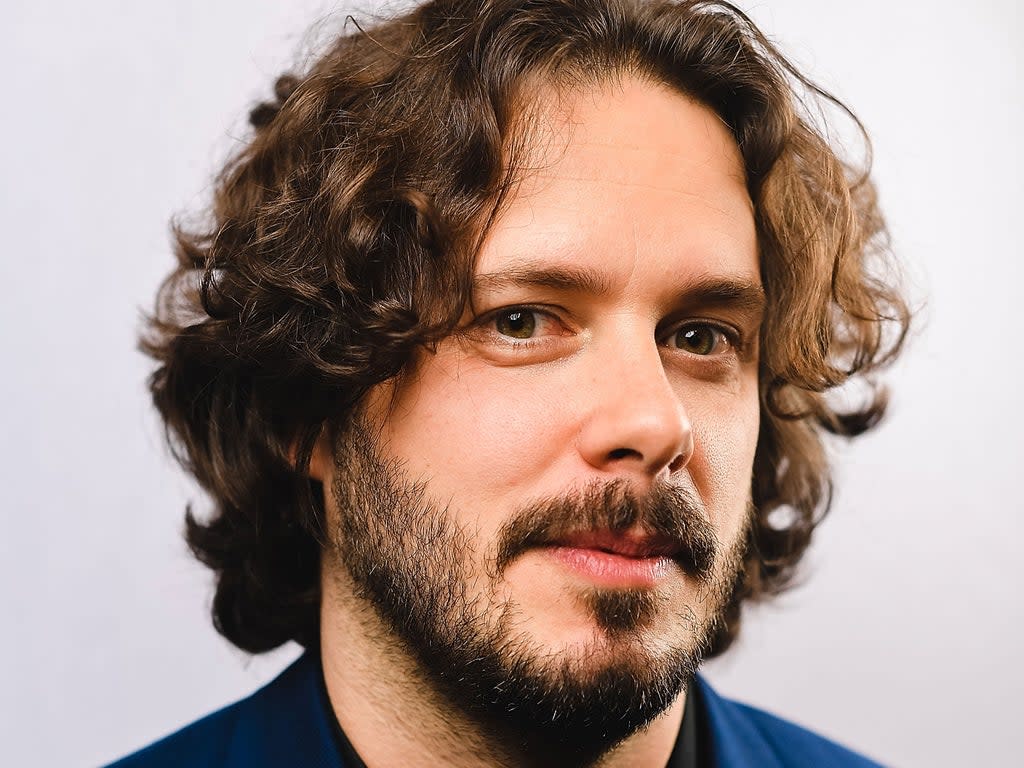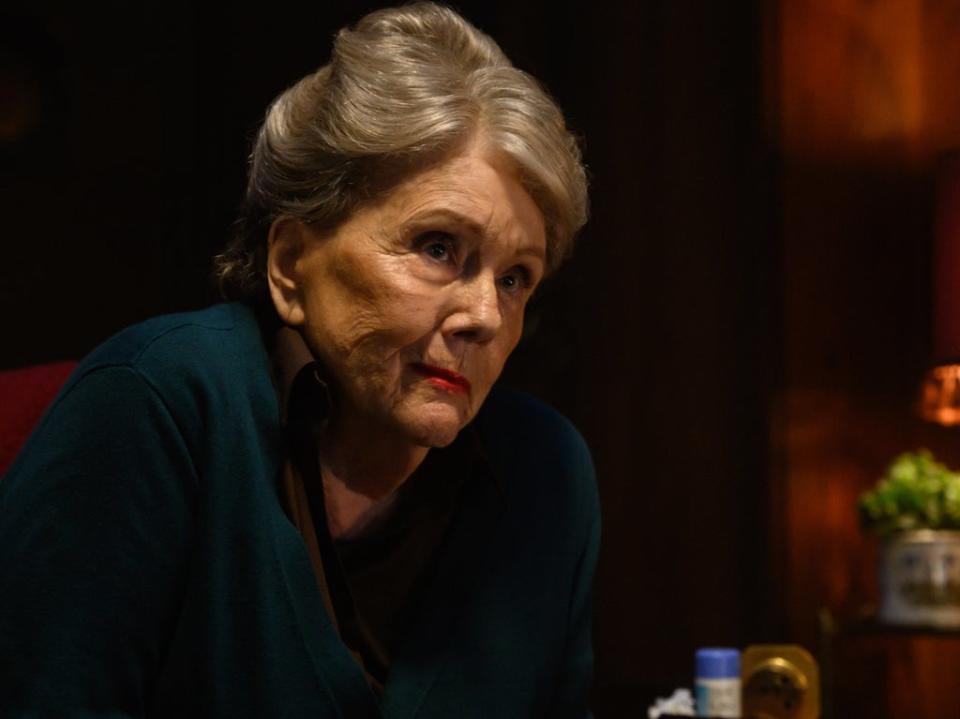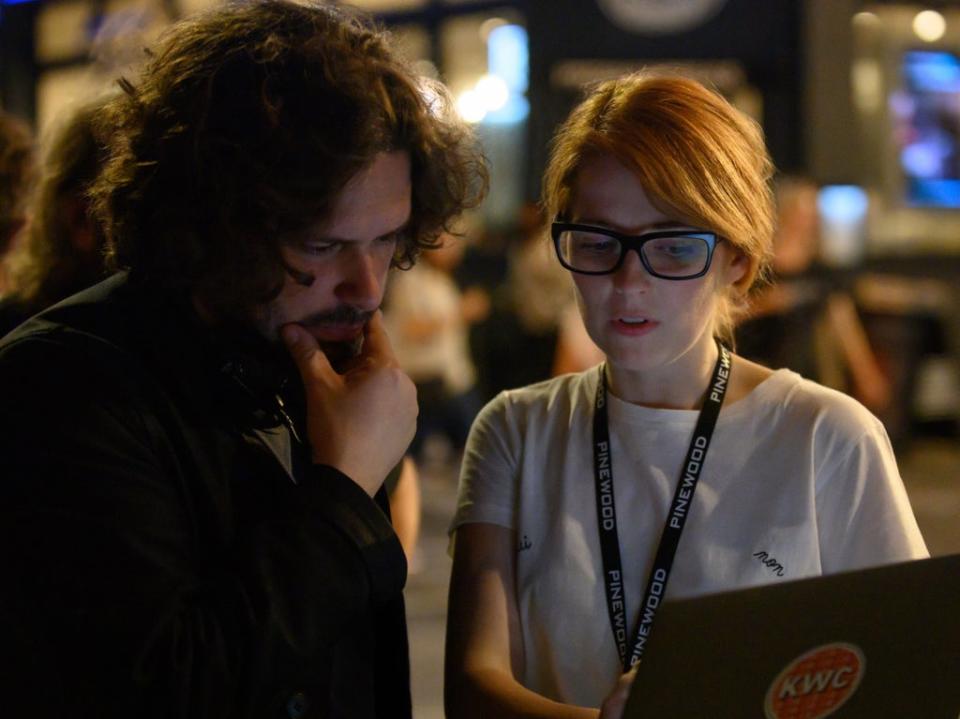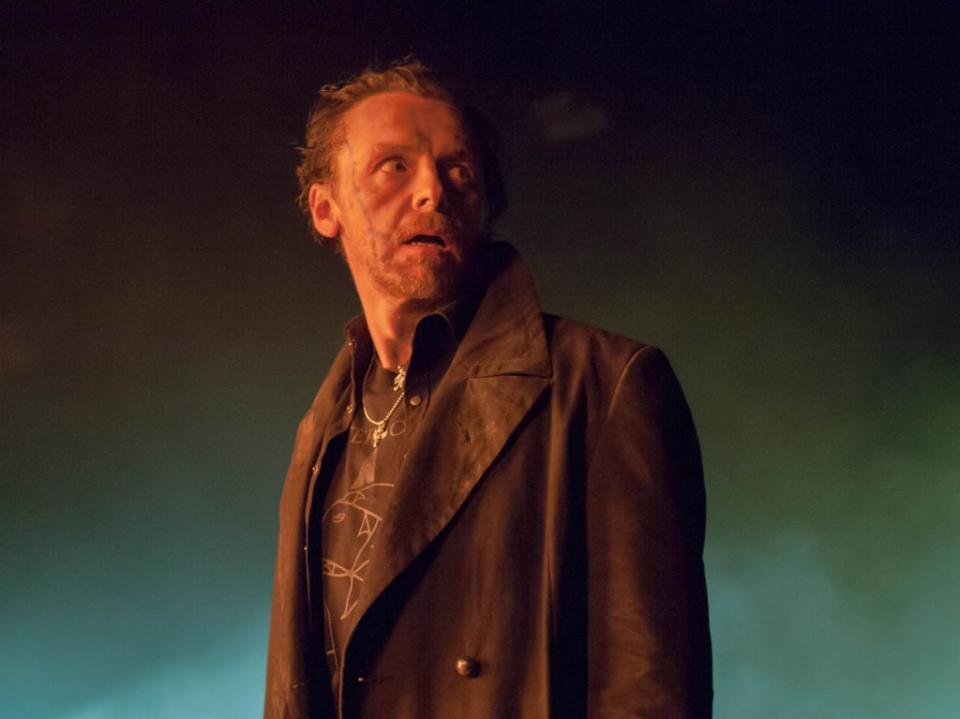Edgar Wright: ‘The idea of there being the good old days in any form is a fallacy’

- Oops!Something went wrong.Please try again later.
- Oops!Something went wrong.Please try again later.
I still get anxiety at the start of every working day,” says Edgar Wright, now almost 27 years into his filmmaking career. Outwardly, the director of Hot Fuzz and Shaun of the Dead is confident – gregarious even, both on set and today on video call from a London hotel – but he is hardly immune to nerves. “I get asked by film students if I ever suffer from imposter syndrome,” he explains, “and I say, ‘Yes, every single day.’ I always walk onto set thinking that I’m going to be found out, especially when you’re trying something new. You’re putting yourself out there. And with this, I’m putting myself out there.”
“This” is Last Night in Soho, one of the most startling films of Wright’s career to date. Those expecting the wit and geeky weirdness of his directorial debut, A Fistful of Fingers, or hit Channel 4 television series Spaced may be disappointed. There’s no zombie apocalypse to contend with, as in Shaun of the Dead, no murderous village preservation societies, Hot Fuzz-style, and no blue-blooded aliens trying to take over Earth, à la The World’s End. There’s no Scott Pilgrim vs The World comic-book wizardry either, and nor are there any thrill-seeking Baby Driver car chases. As about-turns go, it’s a sharp one.
“It’s nearly a decade since I spoke about it to my producer, Nira Park,” Wright explains, sitting on the carpet of his hotel room, back against the sofa. “I was gearing up to do something radically different with this. Having done Baby Driver – which wasn’t an outright comedy, it was more of an action thriller – certainly helped. If I’d gone from The World’s End into this, people would have gotten whiplash. I think for better or worse, the best thing to do is always bite off more than you can chew.”
Last Night in Soho is certainly an ambitious film. The dark psychological thriller sees teenager Eloise (Thomasin McKenzie) travel from Cornwall to London to study fashion. She’s obsessed with the Sixties and finds herself living in a Soho bedsit with landlady Ms Collins (Diana Rigg) after struggling to adjust to living in halls with her peers. She also happens to have a psychic ability, and starts to connect with the story of Sandie (Anya Taylor Joy) and Jack (Matt Smith) through dream-like time travels from her room into the dark, seedy underbelly of Sixties Soho. The “Swinging Sixties” narrative is flipped on its head entirely: here, it’s a place where women’s dreams are shattered in a world dominated by toxic masculinity.
Watch: 'Last Night In Soho' writer 'plucked plot point from real life'
Four of the film’s actors were at the height of their fame in that very decade: Rita Tushingham, Terrence Stamp, Diana Rigg and Margaret Nolan. Rigg died in September 2020, when Wright was in his additional filming phase post-lockdown (he dedicated the film to her), and Nolan just a month later in October 2020. “They were the epicentre of the scene we’re portraying in the film and their perceptions were really fascinating to me,” Wright says, still clearly affected by the loss. With Rigg in particular, Wright had built up a friendship beyond the film: he visited her just two weeks before she died.
“A fond memory in early lockdown was speaking to Diana every couple of weeks about what films she’d been enjoying on Talking Pictures TV – a channel we both loved,” Wright says. “It’s still tough for me to talk about her without welling up.” Despite being increasingly infirm, Rigg insisted Wright visit her bedside after lockdown to complete an ADR session (the process of re-recording any unclear dialogue after filming). Wright took her a bottle of Campari, one of her favourite tipples, and the two shared a final drink together while recording her last audios for the film. “I thought that last one was rather good,” she told Wright, delighted to still be working despite her illness. Before he left, the two “had a right old gossip and reminisced about the shoot”. It was the last time he saw her.
Wright has another particularly special memory of Rigg, this one on set in 2019. Rehearsing next to a grandiose mock-up of the famed Café de Paris in London’s West End, she inadvertently revealed a memory to Wright that echoed one of the main themes of the film. “Diana said: ‘Oh, I went there on my 18th birthday to see Shirley Bassey’s first London gig,’” Wright recalls, smiling. “I mean, hearing that alone was just mind-blowing to conceive of. I asked her if she would like to see the set and she said she’d love to. It was magical walking through an empty sound stage with Diana Rigg on my arm and into our Café de Paris. Then she said: ‘Oh it’s amazing, this is exactly as I remember it.’ Then there was this ‘dot, dot, dot’ moment.”

Rigg was silent for a time, taking stock of the scene. “Diana took this pause and said: ‘I remember walking down those stairs and lots of rheumy-eyed men looking me up and down and feeling like a piece of meat.’ She said this unprompted. The whole theme of this movie is almost that ‘dot, dot, dot’ moment – the three dots between the good and the bad. I don’t think she was thinking about the film or Anya’s character, but she’d basically just described Sandie’s first scene in the film.”
The scene in question sees Taylor-Joy’s character walk into a venue with dreams of being a musician. She’s immediately objectified by dozens of men, and later at the hands of her sleazy manager, Jack. On her arrival to London 60 years later, McKenzie’s Eloise is also subjected to unwanted male attention. “It was to show how little has changed [for women],” Wright explains. “It was to stress that everything that is toxic now was just as bad then, perhaps even worse. It was to show a note of caution on overly romanticising the past.”
Those dangers are central to the film. Wright first explained its concept to his co-writer, 1917’s Krysty Wilson-Cairns, on a night out in Soho in 2016 – the night the Brexit vote came in. “I feel like even if we didn’t mean to say this about Brexit, there really is a Nostradamus element to this. The film is a rebuke to looking back with rose-tinted lenses to the past. There’s no perfect decade. The idea of there being the ‘good old days’ in any form is a fallacy – and dangerous, as we have seen. To me, dreaming about the past and being overly nostalgic is a retreat from the present day and perhaps a failure to deal with it.”
This is now the third film of Wright’s “where people have pointed to either a direct nod to Brexit or an indicator of Brexit”, he says with a laugh. “People have said the same thing about Hot Fuzz or The World’s End – that Gary King telling the network to f*** off is essentially like Britain as an isolationist telling the EU to get stuffed and tipping us into an apocalypse immediately.” Wright, who voted to stay in the EU, adds that maybe these people had a point.

Still, he’s been guilty of romanticising the past himself. “I’ve been obsessed with previous decades. If I’m obsessed with the idea of time travel and going back, what does that say about me? Does that say I’d rather live in some fantasy than deal with the modern day? Sadly, probably yes.”
Wright’s previous, male-dominated films haven’t exactly fared well on the Bechdel Test (a measure of how much women feature in a work of fiction). This is the first time he’s had women front-and-centre – though he’s always had a core female film-making team at the heart of his work.
Watch: Edgar Wright 'spoke to Diana Rigg as much as my own mother' during lockdown
This time around, that includes Lucy Pardee. The Bafta-winning casting director for bold coming-of-age drama Rocks spent a year painstakingly researching “real-life testimonies from people who worked in Soho both then and now”, Wright explains. The stories of “back then” were often brutal, and mirrored Sandie’s devastating treatment at the hands of men.
Wright also drew on the experiences of women close to him, as did co-writer Wilson-Cairns (including her own from her days living and working in Soho at the Toucan pub, which features heavily in the film). “Eloise herself is an amalgam of experiences from myself, Krysty, my mother, her mother and grandmother, my sister-in-law,” says Wright. His mum and sister-in-law studied fashion and Wilson-Cairns’ mother and grandmother were seamstresses. “I think one would be surprised at just how much comes from real life, but that hopefully makes the film resonate – injecting the personal into the fantastical,” Wright says, although he’s been doing that for years.

A more surprising autobiographical twist: Wright’s mother is “supernaturally switched on”, just like Eloise. “My brother and I were so envious we didn’t have this ability, but my mother was very receptive in terms of presences and visions.” Has she ever seen a ghost? “Oh yes!” She once told the family she’d seen a ghost of a hanged man in the living room of their 400-year-old Somerset home. The family dismissed the story at first, only to discover some time later that a man did indeed die from suicide in the same room years earlier.
“If I said to people, ‘This is my most autobiographical film,’ they would immediately reply with, ‘What the f*** are you talking about?!’” says Wright. “In the same way when I say Hot Fuzz is very autobiographical, people are like, ‘But wait, you’re not a policeman, and you’ve never had to battle a killer cult!’ But it’s like, ‘Yes, but everything else is true.’” He grew up in a small village just like the one in the film. “I guess in a way, when you make a lot of these films, you’re trying to process your own feelings about times, people and places.”
It was The World’s End, however, co-written with Wright’s friend Simon Pegg, where the most autobiographical processing took place. It was based on Pegg’s real-life alcohol addiction, something the actor spoke about for the first time in 2018. “When we were writing that film, it was still a private matter for Simon. I obviously had known what the issue was. I’d been there – I’d literally been with him in hospital at one point when things had gotten especially bad. Simon had been in recovery for two years when we wrote it, but his addiction was something we talked about through the character of Gary [King, the character Pegg plays in the film].”
When they did the press for the film, Pegg hadn’t yet talked about his battles publicly. “People would ask all the time: ‘Is this Gary King based on anyone you know?’ and we’d always answer: ‘It’s based on lots of people,’ so we’d throw people off the scent.” Pegg was fresh out of therapy and it was still too raw to discuss. When he finally spoke publicly about his battles, “I was very proud of him”, says Wright. “I didn’t know he was going to do that and when I read it in the paper, I called him and said how proud I was of him for talking about it finally. It wasn’t easy.”

Wright says dealing with the personal in filmmaking can be especially tough – but if the result is a better film, it’s worth the pain. “I guess when you see the finished result, it [shows] the reason why you put yourself through it. On the one hand, it’s the best job in the world – I get to do what was once a hobby for me as my job, so I would never complain about it. I’m not working down a coal mine. But it is and can be mentally stressful in ways that are difficult to articulate, or gain any sympathy for.”
One of the most mentally challenging moments for Wright was the anxiety and responsibility that came with being one of the first shoots to open post-lockdown. “When we’d managed to get to the end of the additional shooting on the final day, it was bittersweet for me,” Wright says. “People kept making the same joke, which was like, ‘Oh it’s a shame we can’t keep going’ and it was the first time I felt less like a director and more like an employer. It became very apparent to me that I was a director but also a jobs creator and I felt very responsible for all these people finally getting some work after lockdown. I felt bad we didn’t have more to do.”
After the hit cinemas took during the past year, showing the film on the big screen is important to Wright. “If that opportunity went away forever, I think we’d be really bereft. I get annoyed by the amount of doomy ‘Is cinema dead?’ articles. We should all just be pulling together right now. I honestly have no schadenfreude to any other movies now. Maybe in a pre-pandemic time, I might be a bit sniffy about certain big franchises that I didn’t care for. I’m now pulling for everything. I saw No Time to Die last week for a second time and I got emotional being in a busy cinema with an excited audience. I started to well up during the adverts.” He smiles. “If it’s saving cinema, then it’s good.”
Read More
How Spencer, The Crown and the internet turned Princess Diana into a Gen-Z queen
If this mega Chinese blockbuster is propaganda, what are Bond and Captain Marvel?
Anthony Michael Hall: ‘Fame was off-putting and kind of scary – it’s not unlike a horror movie’
Some Like Him Not: Why Billy Wilder divides opinion
The 50 best original films to watch on Netflix, ranked
How Spencer, The Crown and the internet turned Princess Diana into a Gen-Z queen

